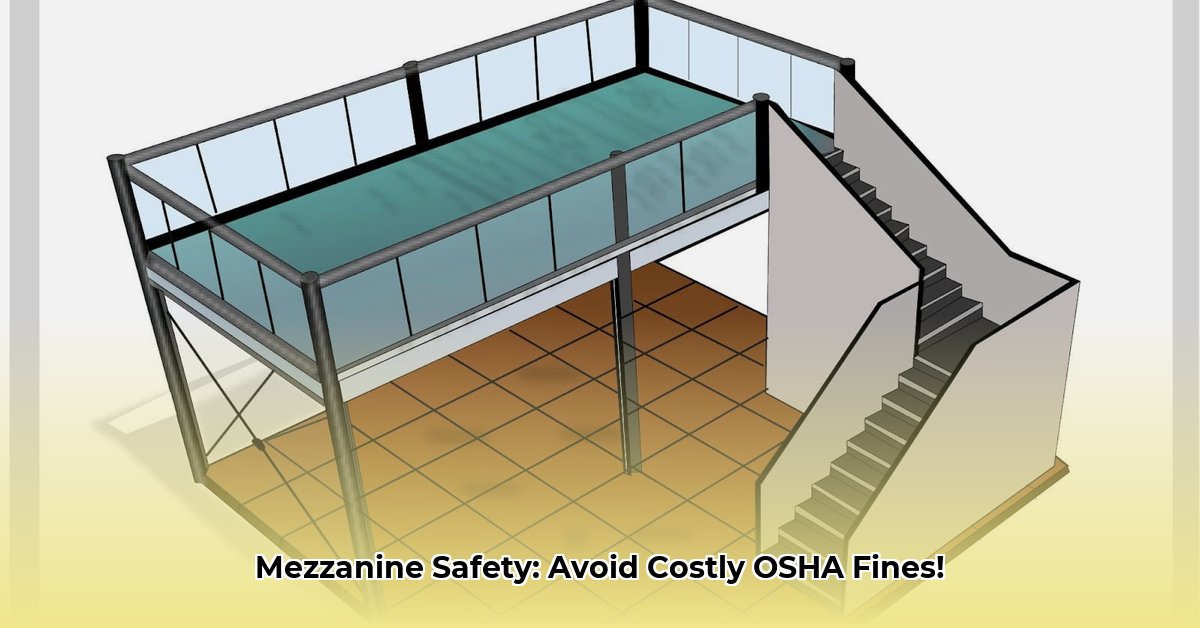Want to make the most of your mezzanine floor without risking injury or hefty fines? This guide is your essential handbook for keeping your mezzanine safe and compliant. We’ll walk you through everything you need to know, from the basics of design and installation to regular maintenance and what to watch out for to avoid problems. Think of it as your checklist for a safe and productive workspace above it all. We’ll cover all the important rules and regulations to keep everyone safe and your business running smoothly. For more design standards, check out mezzanine design standards.
Mezzanine Floor Safety Requirements: A Practical Guide
Let’s talk about mezzanine safety – it’s more than just a floor; it’s a workplace that needs to be safe and compliant. We’ll cover the essentials to keep your employees safe and your business out of trouble. Let’s explore mezzanine safety regulations.
Understanding the Rules of the Game
Building and using a mezzanine safely means playing by two sets of rules: the International Building Code (IBC) and Occupational Safety and Health Administration (OSHA) guidelines. These rules aren’t just suggestions; they’re legally binding, and failing to follow them can be expensive (heavy fines) and even dangerous (serious injuries or worse).
The IBC is all about the structure itself – making sure it’s built strong and correctly from the ground up. OSHA, on the other hand, focuses on keeping workers safe while they’re using the mezzanine. Think of it like this: the IBC ensures the building is sound, while OSHA ensures it’s a safe place to work. Both are crucial for a safe mezzanine. This section underlines OSHA mezzanine standards.
Building a Safe Mezzanine: Design and Construction
Several key elements are critical for a safe mezzanine. Let’s break them down:
- Guardrails: Your First Line of Defense: Imagine guardrails as your safety net. They’re absolutely essential to prevent falls. Regulations usually specify a minimum height (often around 42 inches) and a strength that can handle a significant impact. According to OSHA 1910.29(b), guardrails must be able to withstand a force of at least 200 pounds applied in a downward or outward direction within 2 inches of the top edge. Regular checks are crucial; a weakened guardrail is a major hazard.
- Escape Routes: Planning Your Exit Strategy: Think about how people get off the mezzanine if something goes wrong. The number of exits depends on the size of the mezzanine and its occupancy. IBC Section 1009 dictates specific requirements for stairways used as a means of egress, including minimum width, rise, and tread dimensions. Make sure these escape routes are clear, easily accessible, and won’t become bottlenecks in an emergency.
- Headroom: Avoiding Unpleasant Head-Bumps: Enough headroom above and below the mezzanine is critical to avoid injuries. A general recommendation is usually around 7 feet of clearance to prevent collisions. IBC Section 505.2.1 specifies that the clear height above and below a mezzanine floor must not be less than 7 feet.
- Weight Limits: Don’t Overload!: Mezzanines aren’t designed to hold unlimited weight. Knowing and respecting the weight limits is essential to prevent structural damage or collapse. Regular monitoring helps ensure the mezzanine isn’t overloaded. Posted weight limit signs should be clearly visible, indicating the maximum load per square foot the mezzanine can safely support.
- Flooring: Choosing the Right Surface: The type of flooring plays a big role in safety. You’ll want something slip-resistant, especially in areas where spills are likely. The best flooring choice will depend on the specific tasks performed on the mezzanine. Consider options like epoxy coatings or non-slip mats in high-traffic areas.
Keeping it Safe: Ongoing Maintenance and Procedures
Building a safe mezzanine is just the first step. Keeping it safe requires ongoing attention. This area focuses on mezzanine floor maintenance.
Regular Inspections: Catching Problems Early: Think of regular inspections as a health check for your mezzanine. Conduct weekly visual checks for any signs of damage, wear, or loose components. Schedule annual inspections of the entire structure combined with more frequent checks on things like guardrails are crucial for early problem detection. Keep detailed records of these inspections, noting any findings and corrective actions taken.
Worker Training: Empowering Your Team: Train your employees on safe mezzanine use, emergency procedures, and what to do if they spot a potential safety hazard. OSHA mandates specific training requirements for employees working on elevated surfaces, including fall protection measures and hazard recognition. Regular refresher courses ensure everyone stays informed and aware.
Smart Material Handling: Preventing Accidents: Establish clear procedures for handling materials on the mezzanine. This includes designated areas for dropping or stacking materials and appropriate equipment use to minimize risks. Ensure proper training on the safe operation of forklifts and other material handling equipment, adhering to OSHA guidelines for powered industrial trucks (29 CFR 1910.178).
Minimizing Risks and Staying Compliant
Following these guidelines will significantly reduce the risk of accidents and ensure you’re meeting legal requirements. Remember, not adhering to safety regulations can have serious consequences—for your workers and your business. Staying updated on current regulations and best practices is key.
Potential Challenges and Ongoing Research:
While the information is based on widely accepted standards, the field of mezzanine safety is constantly evolving. New research may lead to refinements in recommendations. For example, ongoing research into material science might suggest new, even safer flooring options. The best approach is always to proactively check for updates to ensure you are working with the most current and comprehensive safety guidelines. Always consult with qualified professionals, such as a licensed structural engineer or a certified safety professional, to ensure your mezzanine design and maintenance programs meet all current and future safety requirements.
How to Ensure Mezzanine Floor Compliance with IBC and OSHA Regulations
Key Takeaways:
- Mezzanine safety hinges on a multi-layered regulatory framework.
- Federal (OSHA), national (IBC), and local building codes must be followed.
- Fall protection, safe egress, and structural integrity are paramount.
- Thorough inspections and maintenance are essential for ongoing compliance.
- Non-compliance carries significant legal and safety risks.
Understanding the Regulatory Landscape
Building a mezzanine isn’t just about construction; it’s about navigating a complex web of regulations. How to ensure mezzanine floor compliance with IBC and OSHA regulations requires understanding the interplay between the International Building Code (IBC), Occupational Safety and Health Administration (OSHA) standards, and local building codes. These regulations often overlap, sometimes with subtle differences. This means diligent research is crucial before you even break ground. Remember, penalties for non-compliance are significant – financial and otherwise.
Essential Safety Features: Fall Protection and Egress
Let’s focus on the core safety elements. What are the most important aspects of mezzanine safety? Fall protection is non-negotiable. Guardrails, toeboards, and other fall arrest systems are mandatory, meeting specific height and strength requirements outlined in both IBC and OSHA standards. These aren’t optional extras; they’re fundamental components of a safe working environment. Secondly, ensure easy and safe egress. Staircases must meet precise dimensions and specifications, providing safe and convenient access to and from the mezzanine level. Think of it like this: if workers can’t get on or off the mezzanine safely, the entire structure is compromised.
Structural Integrity: Load Capacity and Regular Inspections
The structural integrity of your mezzanine is paramount. It must support both live loads (people, equipment) and dead loads (the weight of the structure itself). Proper engineering calculations are essential to determine the appropriate load-bearing capacity for your specific application. Regular inspections aren’t just a good idea; they’re a necessity. Think of them as essential health checks for your mezzanine. Regularly scheduled inspections, conducted by qualified professionals, identify potential problems early on, preventing much larger – and more expensive – issues. What level of inspections is sufficient? It depends on different factors, including usage and environmental conditions. Consult with an expert to determine the appropriate frequency.
Step-by-Step Compliance: A Practical Guide
- Initial Assessment: Conduct a thorough review of all applicable IBC and OSHA regulations, as well as local building codes. Document your findings and create a checklist to ensure all requirements are addressed.
- Professional Design: Engage a structural engineer experienced in mezzanine design to ensure your plans meet all relevant codes. Obtain stamped and approved drawings that clearly demonstrate code compliance.
- Material Selection: Specify materials that meet or exceed the strength and fire-resistance requirements of the applicable codes. Obtain material certifications to verify compliance.
- Permits and Approvals: Obtain all necessary permits before starting construction. Engage with local authorities to ensure a smooth and compliant process. Schedule pre-construction meetings with inspectors to address any potential concerns.
- Construction and Installation: Adhere strictly to the approved design and specifications throughout the construction phase. Implement a quality control program to monitor workmanship and ensure compliance with approved drawings.
- Inspections: Schedule regular inspections, utilizing certified professionals specializing in mezzanine structures. Maintain detailed inspection reports and promptly address any identified deficiencies.
- Maintenance: Establish a comprehensive maintenance plan based upon factors like environmental conditions and usage. Train personnel on proper maintenance procedures and maintain records.
Navigating Discrepancies and Local Variations
While IBC and OSHA provide a solid foundation, minor discrepancies can arise. Local codes often add layers of specificity. What does this mean for you? Thorough research is essential. Don’t assume one code covers everything. Always consult with local
- Glass Wall Tile Ideas for Kitchens and Bathrooms - December 6, 2025
- Glass Tile Bathroom: Create a Beautiful, Easy-Clean Space - December 5, 2025
- Glass Tile: Brighten Your Home With Stylish Glass Backsplashes - December 3, 2025










